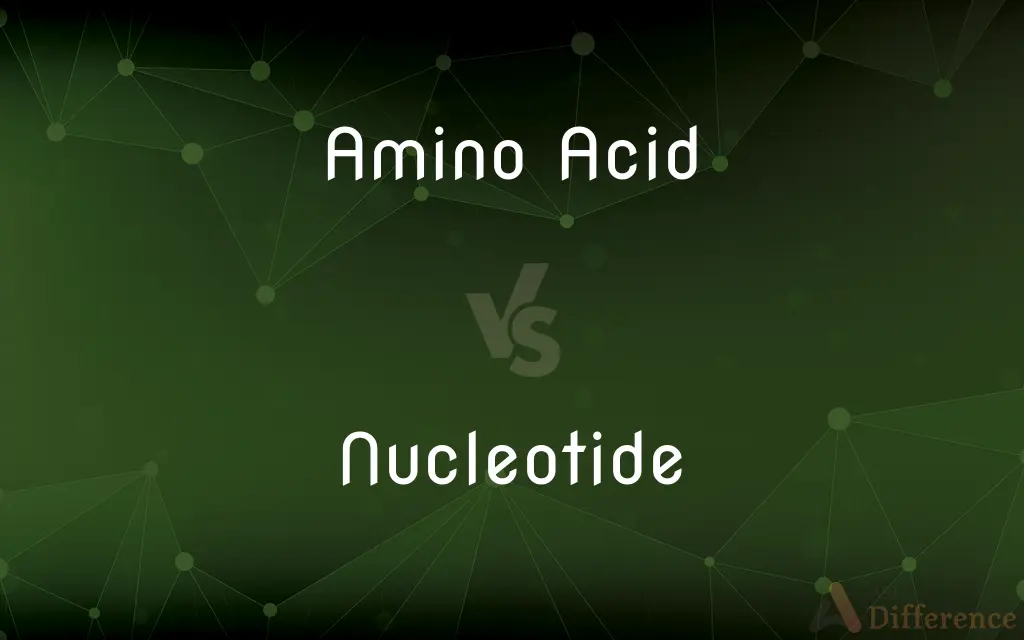Amino Acid vs. Nucleotide — What's the Difference?
By Tayyaba Rehman — Published on November 11, 2023
Amino Acid is a building block of proteins, while Nucleotide forms the structure of DNA and RNA.

Difference Between Amino Acid and Nucleotide
Table of Contents
ADVERTISEMENT
Key Differences
Amino Acid and Nucleotide are essential molecules in the realm of biology, each serving distinctive purposes. Amino Acids are the basic units or monomers that come together to form proteins. They contain an amino group, a carboxyl group, and a unique side chain. On the other hand, Nucleotides are the monomers of nucleic acids like DNA and RNA. They consist of a five-carbon sugar, a phosphate group, and a nitrogenous base.
While Amino Acids engage in peptide bond formation to create polypeptides, Nucleotides bond through phosphodiester linkages to form strands of nucleic acids. The sequence of Amino Acids in a protein dictates its structure and function, whereas the sequence of Nucleotides in DNA or RNA holds genetic information. It's also worth noting that there are 20 standard Amino Acids that make up proteins in organisms, while there are four primary types of Nucleotides in DNA (and a slightly different set in RNA).
Therefore, while both Amino Acids and Nucleotides are foundational to life, they have distinct roles: Amino Acids in protein synthesis and function, and Nucleotides in genetic information storage and transfer.
Comparison Chart
Components
Amino group, carboxyl group, side chain.
Sugar, phosphate group, nitrogenous base.
Function
Building blocks of proteins.
Monomers of nucleic acids (DNA and RNA).
ADVERTISEMENT
Bond Formation
Peptide bonds.
Phosphodiester linkages.
Varieties
20 standard types.
Four main types in DNA, slightly varied in RNA.
Significance
Determines protein structure and function.
Holds genetic information.
Compare with Definitions
Amino Acid
Contains an amino group and a carboxyl group.
Each Amino Acid has a specific side chain that gives it its properties.
Nucleotide
Basic unit of nucleic acids.
A sequence of Nucleotides forms the genetic code in DNA.
Amino Acid
Integral to body metabolism and function.
Certain Amino Acids are essential because the body cannot synthesize them.
Nucleotide
Can act as signaling molecules.
Some Nucleotides serve as secondary messengers in cellular pathways.
Amino Acid
Varying side chains provide diverse properties.
The polarity of an Amino Acid is determined by its side chain.
Nucleotide
Comprises a sugar, phosphate group, and nitrogenous base.
Each Nucleotide in RNA contains the sugar ribose.
Amino Acid
Building blocks of proteins.
The sequence of Amino Acids determines the structure of a protein.
Nucleotide
Involved in cellular energy transfer.
ATP, a high-energy Nucleotide, powers many cellular processes.
Amino Acid
Participate in various biochemical reactions.
Some Amino Acids act as neurotransmitters in the nervous system.
Nucleotide
Essential for storing and transferring genetic information.
Nucleotides in DNA provide the instructions for building and maintaining the organism.
Nucleotide
Any of a group of compounds consisting of a nucleoside combined with a phosphate group and constituting the units that make up DNA and RNA molecules.
Nucleotide
(biochemistry) The monomer constituting DNA or RNA biopolymer molecules. Each nucleotide consists of a nitrogenous heterocyclic base (or nucleobase), which can be either a double-ringed purine or a single-ringed pyrimidine; a five-carbon pentose sugar (deoxyribose in DNA or ribose in RNA); and a phosphate group.
Nucleotide
A phosphate ester of a nucleoside; one of the monomeric components of DNA or RNA.
Nucleotide
A phosphoric ester of a nucleoside; the basic structural unit of nucleic acids (DNA or RNA)
Common Curiosities
How many standard Amino Acids are there?
There are 20 standard Amino Acids.
Why are Nucleotides essential for life?
Nucleotides store and transfer genetic information essential for growth, development, and reproduction.
Can Amino Acids be synthesized by the body?
While some Amino Acids can be synthesized by the body, others, known as essential Amino Acids, must be obtained from the diet.
What is the primary role of Amino Acids?
Amino Acids are the building blocks of proteins.
How do Nucleotides relate to DNA?
Nucleotides are the monomers that make up the structure of DNA.
What's the difference between DNA and RNA Nucleotides?
DNA Nucleotides contain deoxyribose sugar, while RNA Nucleotides contain ribose sugar.
Are Amino Acids only found in proteins?
While Amino Acids are primarily known as building blocks of proteins, they also have other roles in metabolism and biochemistry.
Which parts constitute a Nucleotide?
A Nucleotide consists of a sugar, phosphate group, and a nitrogenous base.
Can Amino Acids serve as a source of energy?
Yes, in certain conditions, Amino Acids can be metabolized for energy.
Do Nucleotides play a role in energy transfer?
Yes, ATP, a Nucleotide, is a primary energy currency of the cell.
What bonds do Amino Acids form in proteins?
Amino Acids form peptide bonds in proteins.
Share Your Discovery

Previous Comparison
Parachute vs. Hot Air Balloon
Next Comparison
Lipase vs. AmylaseAuthor Spotlight
Written by
Tayyaba RehmanTayyaba Rehman is a distinguished writer, currently serving as a primary contributor to askdifference.com. As a researcher in semantics and etymology, Tayyaba's passion for the complexity of languages and their distinctions has found a perfect home on the platform. Tayyaba delves into the intricacies of language, distinguishing between commonly confused words and phrases, thereby providing clarity for readers worldwide.











































